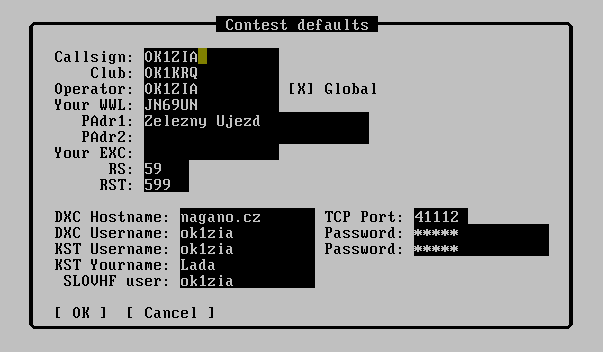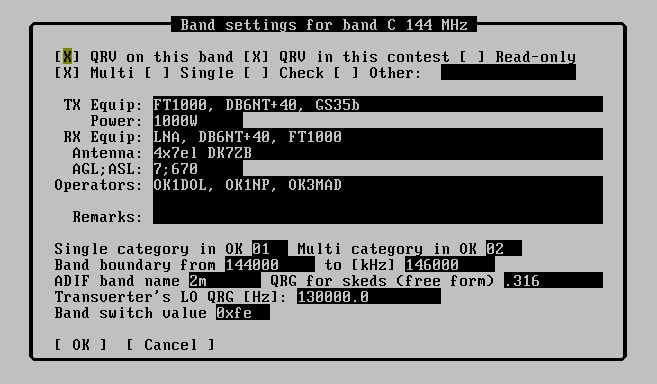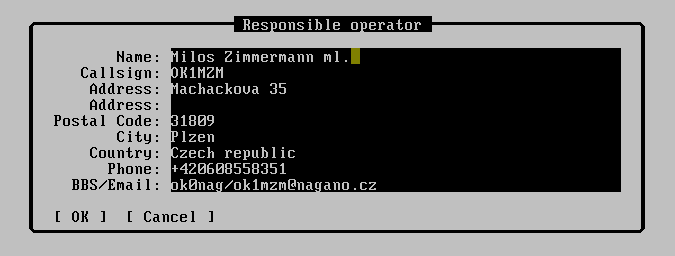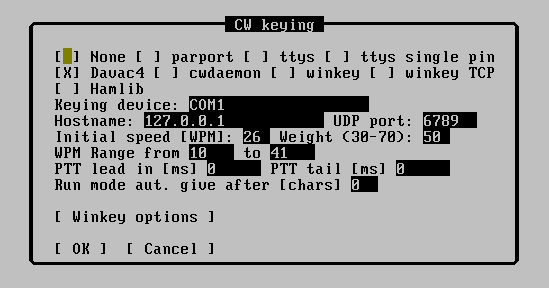Setup: Difference between revisions
| Line 48: | Line 48: | ||
Keying device f.e. /dev/parport0, /dev/ttyS0, /dev/ttyUSB0 | Keying device f.e. /dev/parport0, /dev/ttyS0, /dev/ttyUSB0 | ||
Hostname, UDP port are reserved. | |||
Initial speed says keying speed in WPM after program start. You can change it using PageUp or PageDown keys. | |||
Weighting - changes ratio of mark and space in CW. | |||
<math>t_mark=1200000/speed+weight*500</math> | |||
=SSB daemon= | =SSB daemon= | ||
Revision as of 21:45, 16 November 2007
Contest defaults

There is possible to set these items in this menu: callsign in contest, club callsign (use only if you can export contest log in EDI format), locator (6 characters), contest QTH (is equal items PAdr1 and PAdr2 in EDI, Optional Exchange and standard proposed reports for SSB and CW.
Band defaults

This submenu contains setting of all bands. Active bands (QRV is checked) are separated from other bands. You can take away bands which are never used (as 220MHz in Europe).
You can enter single band setting by pressing ENTER key. Item `QRV on this band' is usually set for all bands where are permit transmittes.
This setting is the only one which must be set. Other items are better set here too but it isn't necessary.
QRV setting in this contest isn't effect on this place. Cathegory can be one of Multi/Single/Check.
TX and RX Equip settings contains describing of equipments. Power is written with units. ASL and AGL means a height between antenna and sea/ground. Inserted values are in meters, delimiter is semicolon.
Fill operator's callsigns into Operators field delimitely by semicolon. Remark field is assigned for remarks to contest commitee.
Responsible operator

There are set information of responsible operator for communication with contest commitee in this dialogue. All items are in free format and don't need commentary.
CW daemon

Since 2.0 Tucnak does not use for keying and transmitting CW external program cwdaemon. It's functions are added in Tucnak.
Keying methods are:
- None - no CW output is used
- lp - uses kernel module ppdev for keying. Recommended device is http://ok1zia.nagano.cz/web/davac3. Pin configuration is:
- 1 STROBE - grounded when active.
- 14 AUTOLF - switch TRX modulation input to microphone or soundcard output
- 16 INIT - PTT
- 17 SELECT IN - CW
- ttys - uses control pins of serial port. Pinout for D-SUB9:
- 4 DTR - CW
- 5 GND - ground
- 7 RTS - PTT
- cwdaemon - not implemented yet
- N/A - reserved
Keying device f.e. /dev/parport0, /dev/ttyS0, /dev/ttyUSB0
Hostname, UDP port are reserved.
Initial speed says keying speed in WPM after program start. You can change it using PageUp or PageDown keys.
Weighting - changes ratio of mark and space in CW.
SSB daemon
Since 2.0 Tucnak takes also SSB CQs and traffic recording.
TODO settings
Hostname and UDP port set IP address and UDP port which is connected for ssbd.
Path to DSP describes path to special file which is connected with sound card kernel driver. Typically is /dev/dsp.
Record traffic switches on/off recording band activity on receiving. If this option isn't active then all next options are irrelevant.
Template for recorded filename is template for naming recording files. Description of possible macros you can find in section CQ macros.
Next options describe coding of output file. Supported options are.
- PCM 8 and 16 bits
- Logarithmic PCM u-law and A-law
- IMA and MS adaptation PCM
- GSM version 6.10 (preferred for me)
PCM coding is suitable for conversion to other formats (MP3, Ogg). GSM coding has low size. One minute of recording have size about 130 kB of disk space. That is less then 200 MB for 24 hours. This coding doesn't have to supported by your favourite player! GSM format replay for example mplayer (with codec) or sndfile-play distributed with libsndfile.
Option Channel sets number of sound channels. Set it to 1 (mono). You can set it to 2 or 4 it depends on your sound card capability.
Sample rate sets the number of sample per second. `CD' quality has value 44100. This value is needless for radio activity. It's recommended to lower value to half (22050) or quarter (11025) because some programs or sound cards can't work with other values. If SSB CQ or recording don't work properly mail to me, please.
CW CQ
The list of all CW texts are showed after selecting this item. There is showed the key for running the message in brakes. Character `R' means that the message is repeated (CQ). Also is showing start of text.
There are these items in dialoque for setting CQ: text of CQ and repeating of the text one. Item delay determines time between starts of CQ messages (not between end of first and start of second). Last item allows to run message if there is any macro undefined.
SSB CQ
See description in previous chapter.
CQ macros
It's possible to define macros in texts of CW CQ and in name of SSB CQ file. Macros are case insensitive.
- $$ - character $
- $C - callsign of opposite station. Warning! Callsign may contains stroke then can be problem to use macros in filename of CQ SSB
- $D - date of contest (20031228)
- $N - contest number from opposite station
- $O - operator's callsign (for SSB CQ filenames)
- $R - report from opposite station.
- $S - serial number of record sample (is refilled by ssbd)
- $T - contest directory (/home/ok1zia/tucnak/20031004.2)
- $V - callsign of opposite station, the stroke character is exchanged by the underline character
- $W - locator of opposite station
- $X - optional exchange from opposite station
- $MC - my callsign
- $MN - contest number from opposite station.
- $MR - report for opposite station
- $MW - my locator
- $MX - my optional exchange
Macros has not effect in all context.
Autosave
It sets and saves parameters of QSO to disk. Option `Save to disk after QSO' is recommended set to 1 to save all reports. Fsync option immediately saves QSOs from cache to disk.
Default setting of option Save to floppy after QSO is 4. Zero disables saving to floppy disk. Path to floppy item sets path to floppy's mount point. Tucnak don't test if floppy disk is mounted.
Other items are ignored.
Network & trace
Ignore interfaces - list of network interfaces which would be ignored for searching next copy Tucnaks on the net (transmit broadcasts) as connect to Internet, public IP address from provider, AX.25 interface. The delimiter between interfaces is space character. Broadcasts loads slow nets.
Ignore networks - the purpose this option is the same as Ignore interface option. You can determinate subnet address.
Announce to nets - it's an inverse function of previous options. There is specification of IP address where have been sending broadcasts in this option. The routers usually have disabled forward broadcastings. Menu Terminal options
This menu is used for setting characteristic of terminal as window frames. Load cfg from net
It shows addresses of all Tucnaks on the net. If one is selected you can read his complete configuration (tucnakrc).
Load C_W from net
It loads complete C_W database from selected Tucnak and saves it to ~/tucnak/tucnakcw. In database are saved two newest locators for each callsign. Save configuration
It saves configuration to file ~/tucnak/tucnakrc
